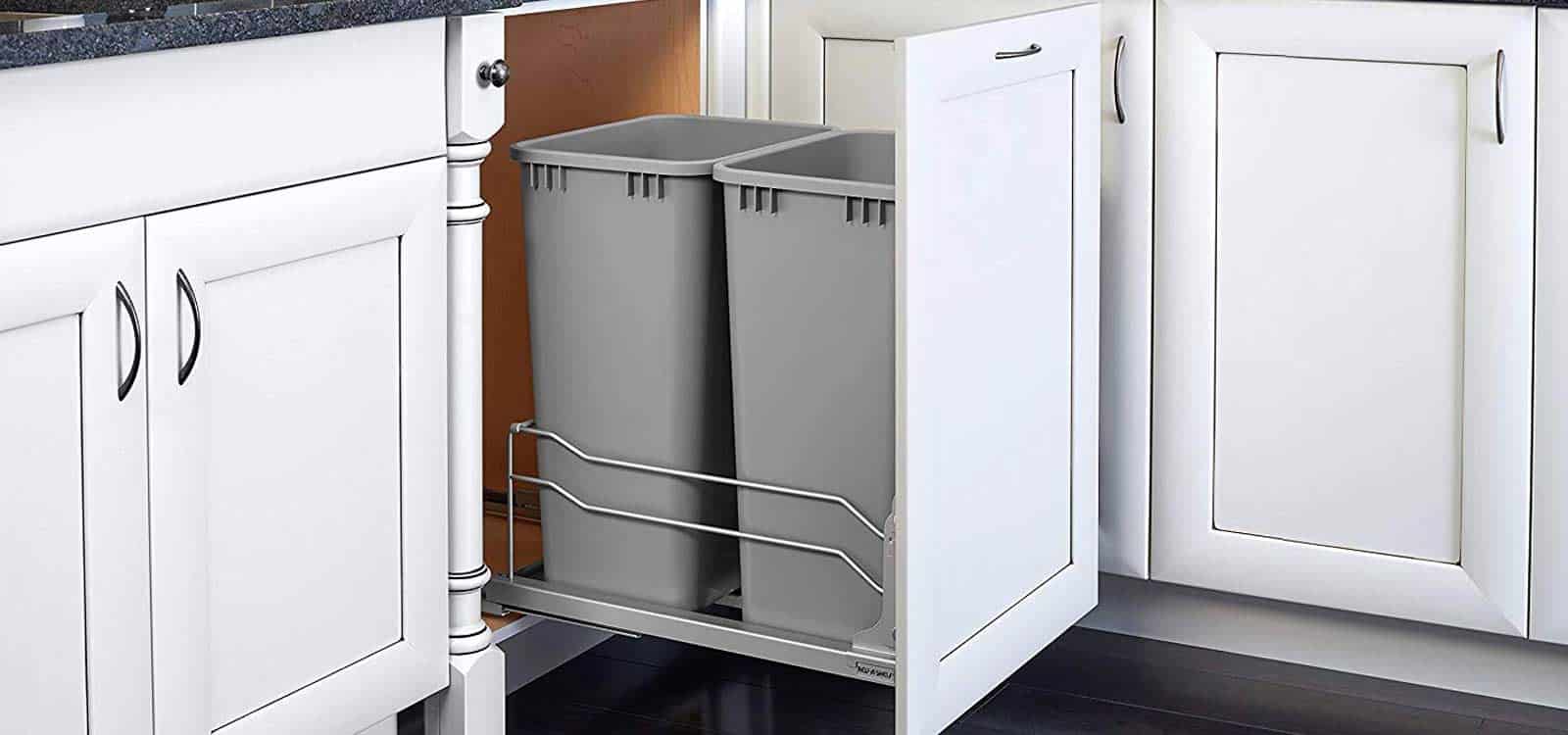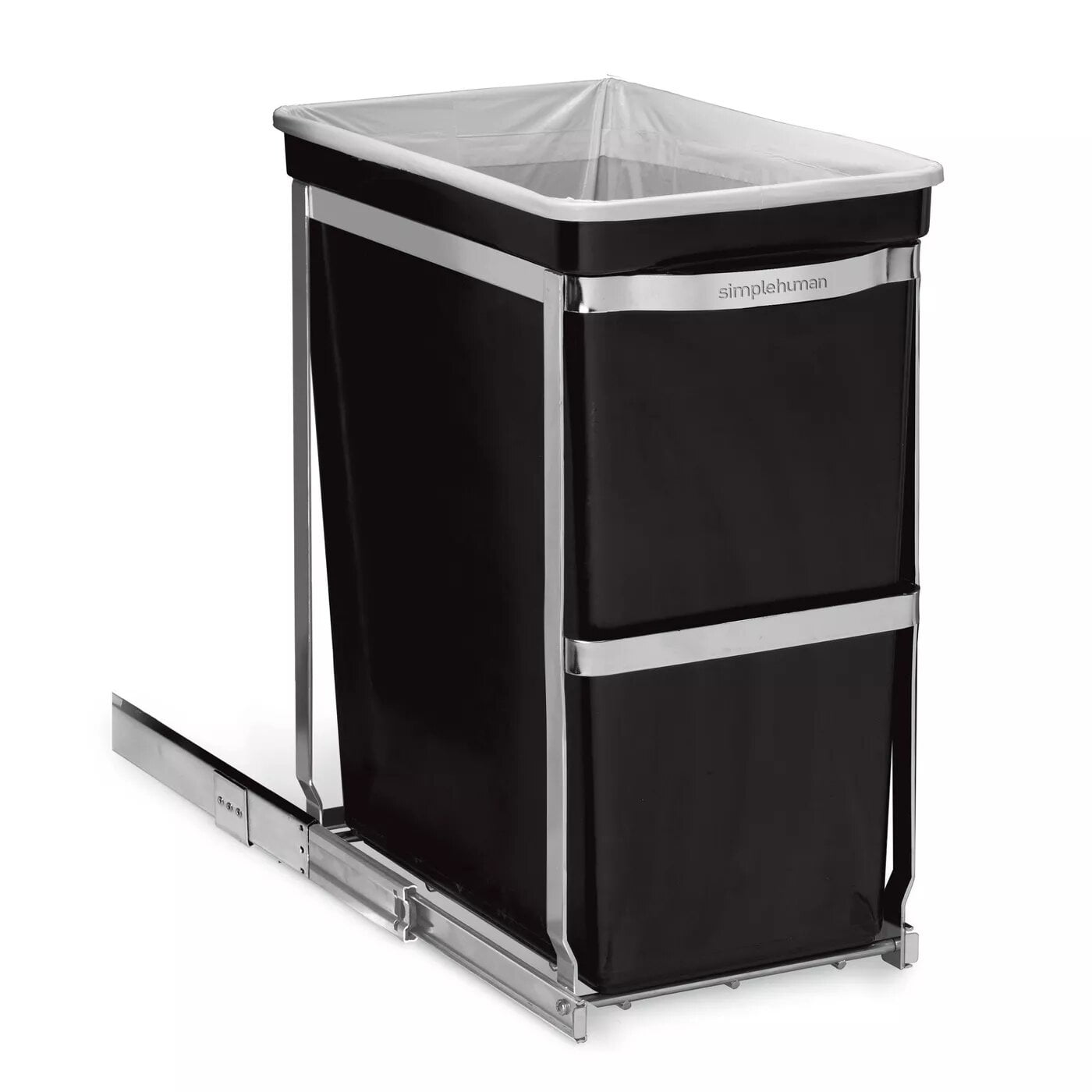Types of Hanging Trash Cans: Hanging Trash Can For Kitchen Cabinet Door

Choosing the right hanging trash can for your kitchen can significantly improve organization and convenience. The market offers a variety of options, each with its own strengths and weaknesses regarding material, mounting mechanism, and overall functionality. Let’s explore the key factors to consider.
Hanging Trash Can Materials
The material of your hanging trash can directly impacts its durability, ease of cleaning, and overall aesthetic appeal. Common materials include plastic, metal, and wood. Plastic cans are generally lightweight and inexpensive, making them a popular choice. However, they can be less durable than metal or wood and may scratch or crack over time. Metal cans, often made of stainless steel, offer superior durability and resistance to damage. They are typically more expensive but provide a more premium look and longer lifespan. Wooden hanging trash cans are less common but can add a rustic charm to your kitchen. However, wood requires more careful maintenance to prevent water damage and staining. Regular cleaning with a damp cloth is sufficient for plastic and metal cans, while wooden cans might need occasional polishing and sealing.
Hanging Trash Can Mounting Mechanisms
Several mounting mechanisms are available for hanging trash cans, each offering a different level of convenience and accessibility. Over-the-door trash cans are simple to install, requiring no tools beyond possibly some adhesive strips. They simply hang over the cabinet door, offering easy access. Slide-out trash cans are integrated into the cabinet itself, typically using a drawer-like mechanism. They are more concealed but require more complex installation, potentially needing modifications to the cabinet. Swing-out trash cans are mounted to the inside of the cabinet door and swing out when opened, offering a balance between accessibility and concealment. Installation usually involves attaching the can to the door using screws or strong adhesive. Each method has its pros and cons; the best choice depends on your cabinet design and personal preference.
Comparison of Hanging Trash Can Models
The following table compares four different hanging trash can models, highlighting key features to aid in your decision-making process. Remember that prices can fluctuate based on retailer and sales.
| Model | Capacity (Gallons) | Dimensions (Inches) | Features | Price Range ($) |
|---|---|---|---|---|
| SimpleHouseware Over-the-Door Trash Can | 1.3 | 10 x 7 x 5 | Plastic, over-the-door mounting, easy installation | 10-20 |
| iDesign Linus Over-the-Cabinet Door Trash Can | 1.5 | 10 x 8 x 6 | Plastic, over-the-door mounting, compact design | 15-25 |
| Rev-A-Shelf 4WC-24-30 Swing-Out Trash Can | 2.0 | 12 x 10 x 12 | Metal, swing-out mounting, requires cabinet modification | 50-75 |
| Hafele 682.85.002 Slide-Out Trash Can | 3.0 | 14 x 12 x 14 | Metal, slide-out mounting, requires cabinet modification, soft-close mechanism | 100-150 |
Practical Considerations and User Experiences

Hanging trash cans offer a clever solution for maximizing space in smaller kitchens, but like any kitchen gadget, they come with their own set of pros and cons. Choosing the right one requires careful consideration of your kitchen’s layout, waste management habits, and personal preferences. Let’s delve into the practical aspects and user experiences associated with these space-saving solutions.
Choosing between a hanging trash can and a traditional freestanding model involves weighing the benefits of space optimization against potential limitations in functionality and capacity. Freestanding cans offer larger capacities and are generally easier to access, but they take up valuable floor space. Hanging units, on the other hand, are perfect for smaller kitchens, keeping waste out of sight and freeing up counter and floor space. However, their capacity is typically limited, and accessing them might require a bit more maneuvering.
Hanging Trash Can Advantages and Disadvantages, Hanging trash can for kitchen cabinet door
Hanging trash cans offer several advantages. Primarily, they significantly save space, a critical benefit in smaller kitchens or those with limited counter space. The out-of-sight placement also contributes to a cleaner, more organized kitchen aesthetic. However, the limited capacity is a major drawback. Frequent emptying is often necessary, especially in households with multiple occupants or significant waste generation. Furthermore, the access mechanism, often involving swinging a door, can sometimes feel less convenient than simply reaching for a freestanding can. The weight of a full bag can also strain the cabinet door hinges over time, necessitating robust hinges and careful consideration of the weight capacity of the chosen model.
Choosing the Right Size and Type of Hanging Trash Can
Selecting the appropriate hanging trash can hinges on several factors. First, carefully measure your cabinet door. The width and depth of the door will determine the maximum size of the trash can that will fit comfortably and securely. Next, consider your waste management needs. Do you recycle or compost? If so, you’ll need a hanging trash can with multiple compartments to accommodate different waste streams. A two-compartment system for trash and recycling is a popular choice, while some models offer even more divisions. Finally, consider the type of mounting system – some use simple hooks while others may require more intricate installation.
User Reviews and Testimonials
User feedback is invaluable when choosing a kitchen product. Here’s a summary of common experiences reported by users of hanging trash cans:
- Ease of Use: Many users praise the convenience of having a readily accessible trash can within the cabinet, eliminating the need to walk across the kitchen to dispose of waste. However, some report difficulty accessing the can, especially when the cabinet door is small or the can is full.
- Cleaning: Cleaning is generally considered easy, especially with removable inner bins. However, some users note that cleaning around the hinges and the area where the can attaches to the door can be challenging.
- Overall Satisfaction: Overall, user satisfaction is generally high, especially among those with limited kitchen space. However, some users express disappointment with the limited capacity and the need for frequent emptying. Others highlight issues with flimsy construction or poorly designed mounting mechanisms.
Creative Design and Integration

Let’s face it, trash cans aren’t exactly known for their aesthetic appeal. But a well-designed hanging trash can can actually *enhance* your kitchen’s style, not detract from it. We’ve already covered the practical aspects, now let’s dive into the fun stuff: creating a trash can that’s both functional and a stylish addition to your culinary domain.
Three Unique Hanging Trash Can Designs
The key to a great hanging trash can lies in thoughtful design. It’s about more than just functionality; it’s about seamlessly integrating the trash can into your existing kitchen aesthetic. Here are three designs that showcase different approaches to achieving this balance:
Hanging trash can for kitchen cabinet door – Design 1: The “Slimline” – A Space-Saving Marvel
Imagine a sleek, rectangular trash can, barely wider than a standard spice rack, crafted from brushed stainless steel. Its minimalist design features a soft-close lid mechanism and a removable inner bucket for easy cleaning. This model is perfect for smaller cabinets and kitchens with limited space. The mounting mechanism is a simple, sturdy clip system that attaches securely to the inside of the cabinet door without visible hardware. The size would be approximately 12 inches tall, 6 inches wide, and 4 inches deep, making it surprisingly spacious despite its slim profile. The brushed stainless steel complements modern and contemporary kitchens, while the subtle design ensures it doesn’t dominate the space.
Design 2: The “Rustic Charm” – A Touch of Country Elegance
This design takes inspiration from farmhouse kitchens. Picture a charming hanging trash can crafted from reclaimed wood, perhaps with a subtly distressed finish. The wood could be stained a warm honey tone or painted a soft, muted color to complement the overall kitchen style. The inner bucket is made from galvanized steel for durability and easy cleaning. A simple rope or leather strap serves as a stylish and functional handle for removing the inner bucket. This model uses heavy-duty hinges for a secure mounting system that integrates smoothly into the cabinet door. The size is slightly larger, approximately 14 inches tall, 8 inches wide, and 5 inches deep, offering more capacity. This design adds a touch of warmth and character, perfect for rustic, traditional, or even eclectic kitchen designs.
Design 3: The “Modern Minimalist” – A Statement Piece
This model embraces bold minimalism. Imagine a hanging trash can made from a single, seamless piece of high-gloss white acrylic. The simple, geometric shape contrasts beautifully against the surrounding cabinetry. A silent-closing, push-to-open lid adds to the sleek aesthetic. The mounting system is cleverly concealed, with a series of small, magnetic catches that hold the trash can securely in place. The size is approximately 10 inches tall, 7 inches wide, and 5 inches deep. This design makes a bold statement, perfect for contemporary or modern kitchens with clean lines and a monochromatic color palette.
Seamless Integration into Kitchen Cabinet Designs
The beauty of a well-designed hanging trash can lies in its ability to disappear into the background, becoming an unobtrusive yet functional part of your kitchen. The choice of materials and colors is crucial here. A stainless steel model will seamlessly integrate into a modern kitchen with stainless steel appliances, while a wooden model will blend perfectly with a rustic or traditional kitchen. Consider the overall color scheme of your kitchen: a neutral-colored trash can will work well with most designs, while a bolder color can be used to add a pop of personality.
For example, a dark grey hanging trash can might create a subtle, sophisticated contrast against light-colored cabinets, while a bright white one could offer a fresh and clean feel in a kitchen with darker cabinetry. The key is to think about the visual weight of the trash can in relation to the surrounding elements. A small, understated trash can will not compete with other design features, while a larger, more statement-making piece should be chosen carefully to ensure it complements the existing design.
